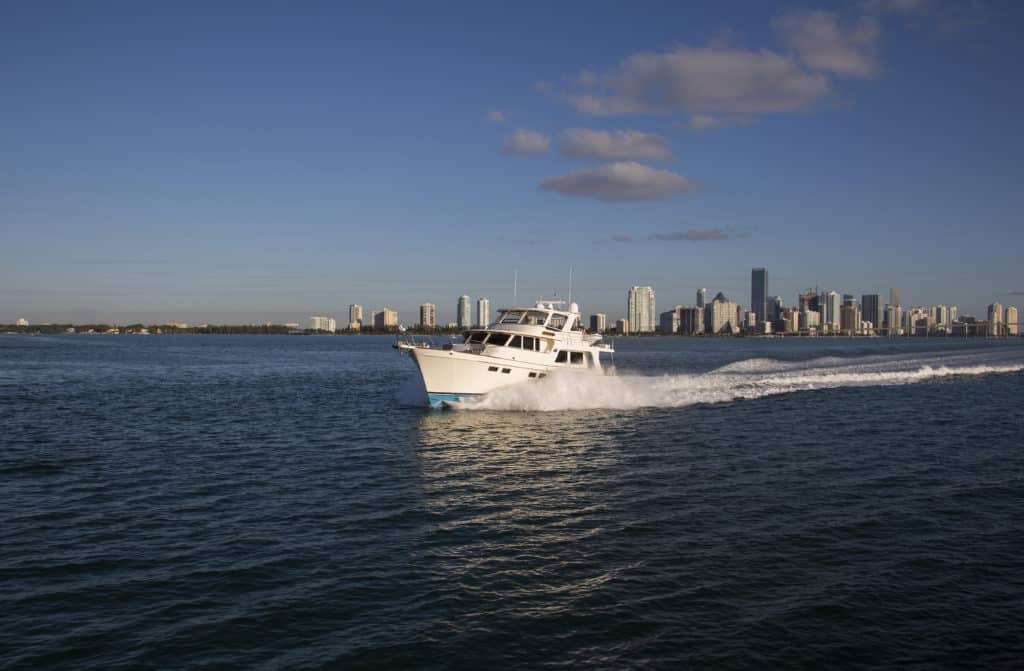
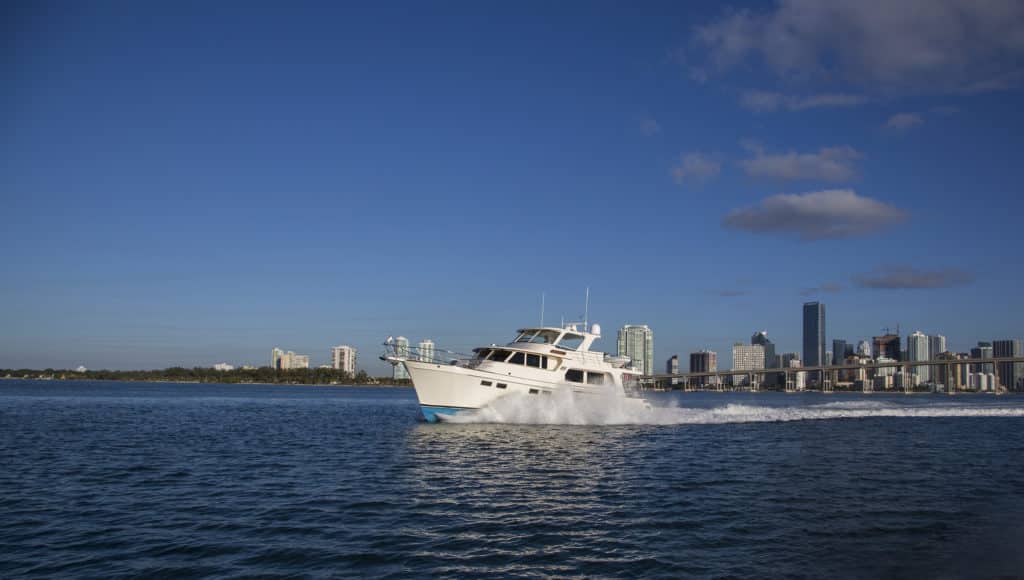
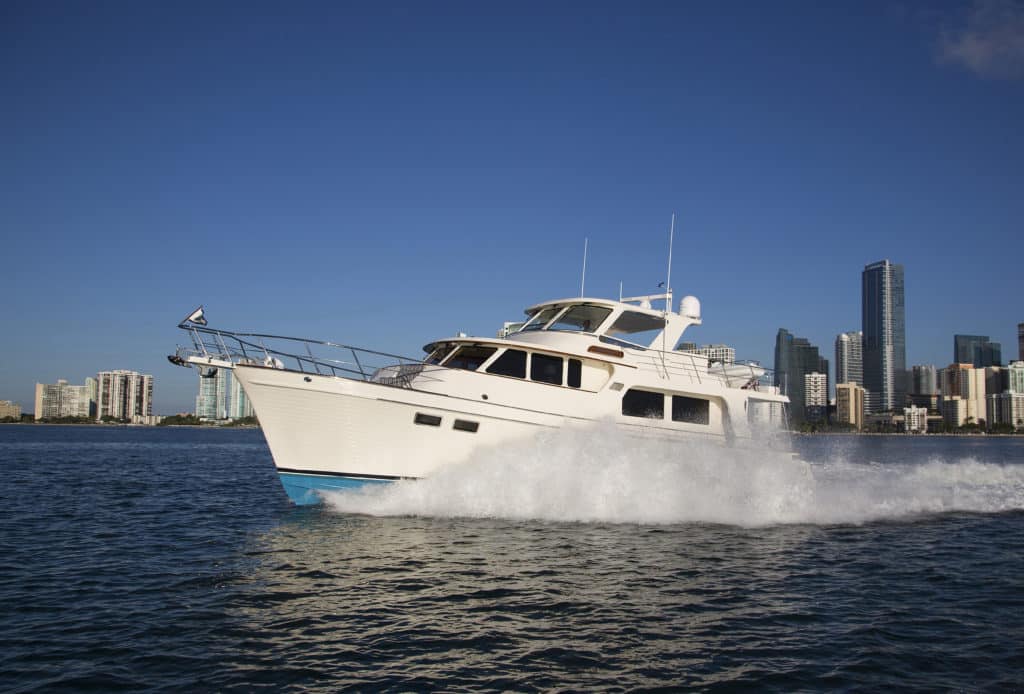
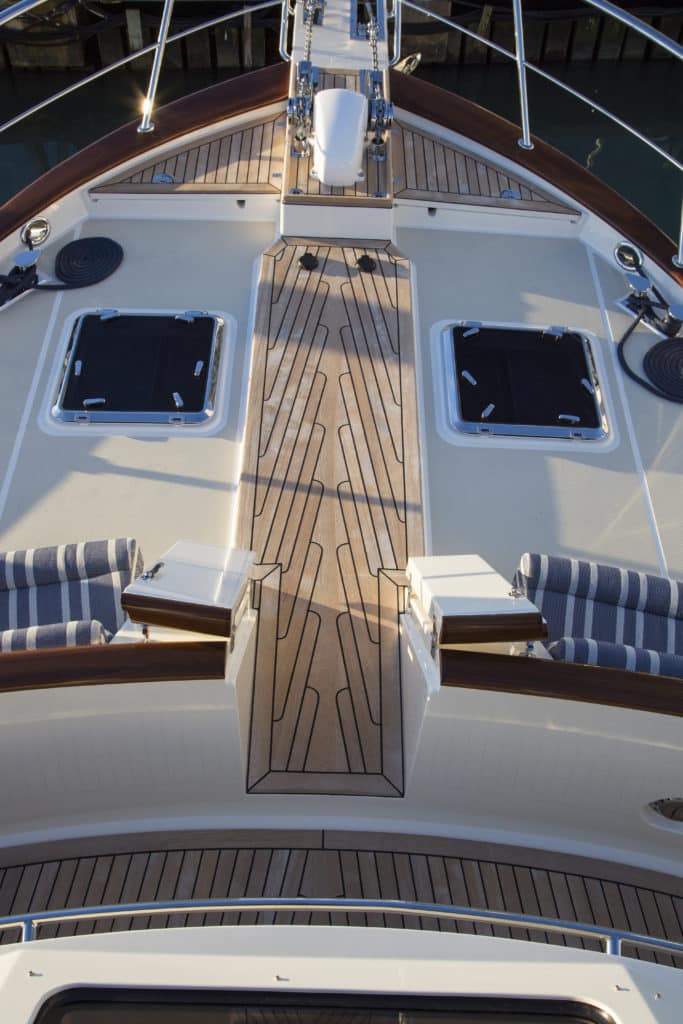
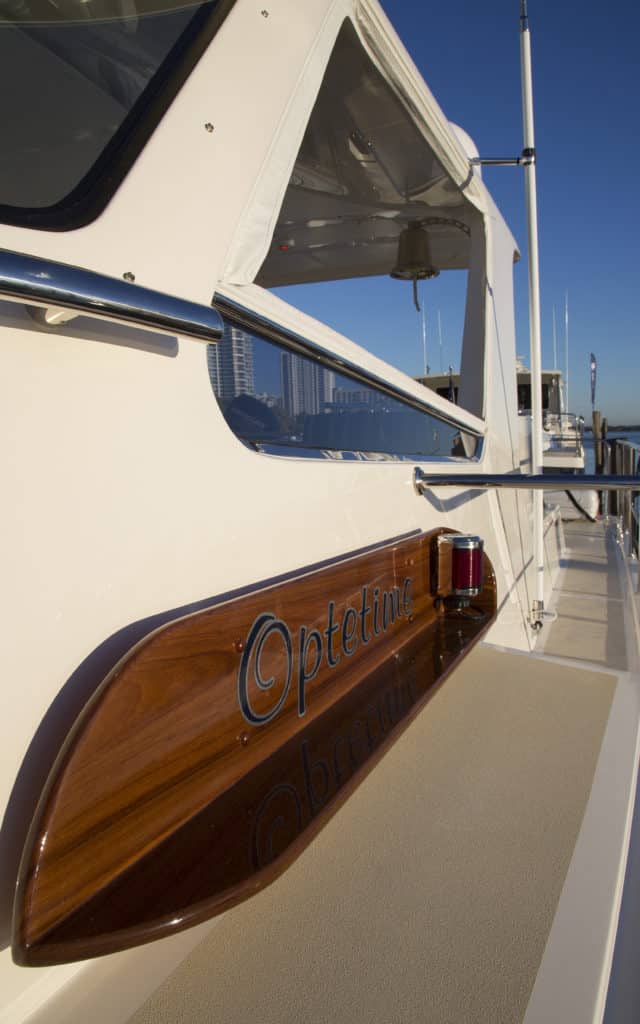
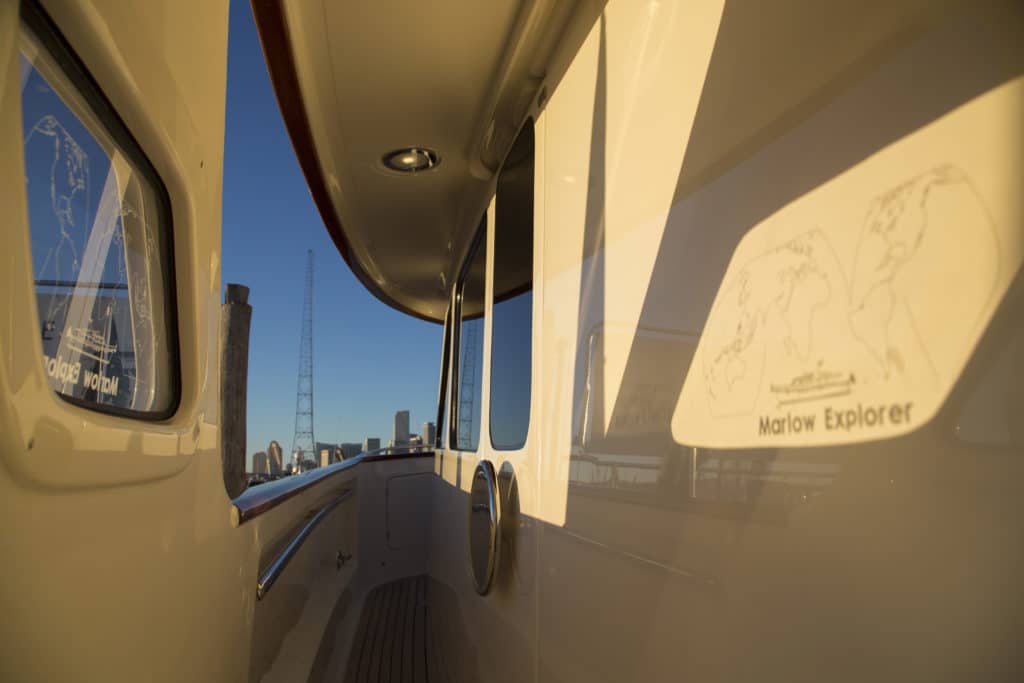
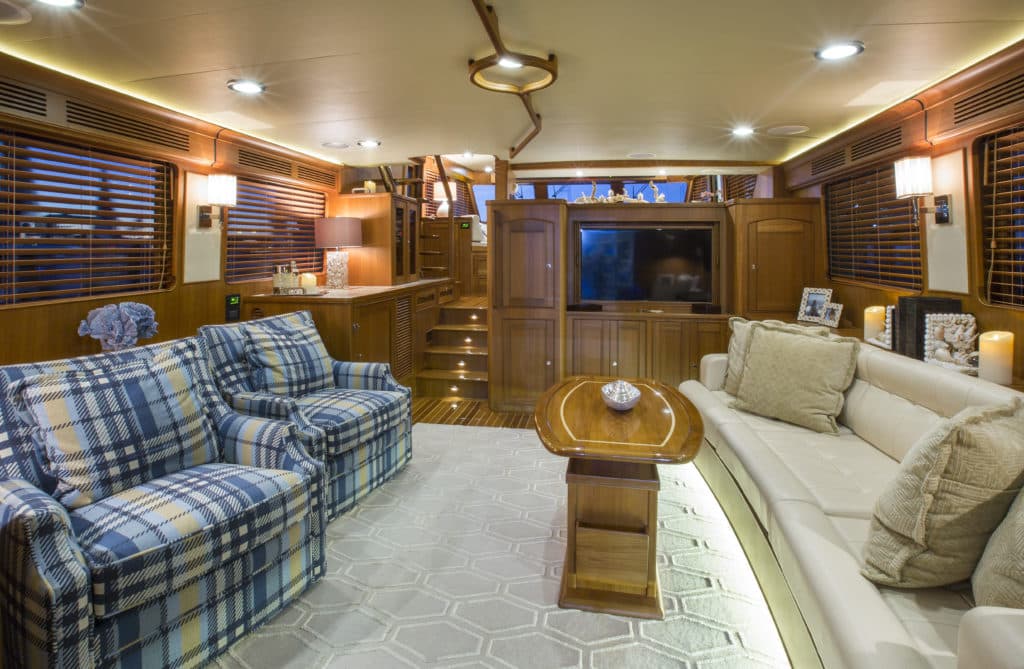
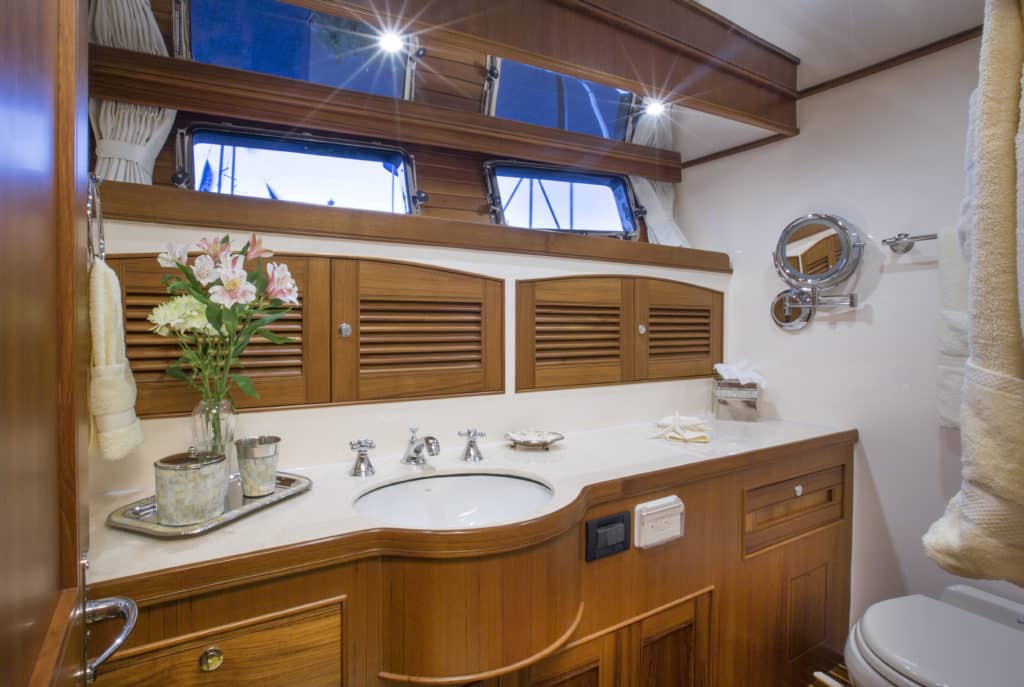
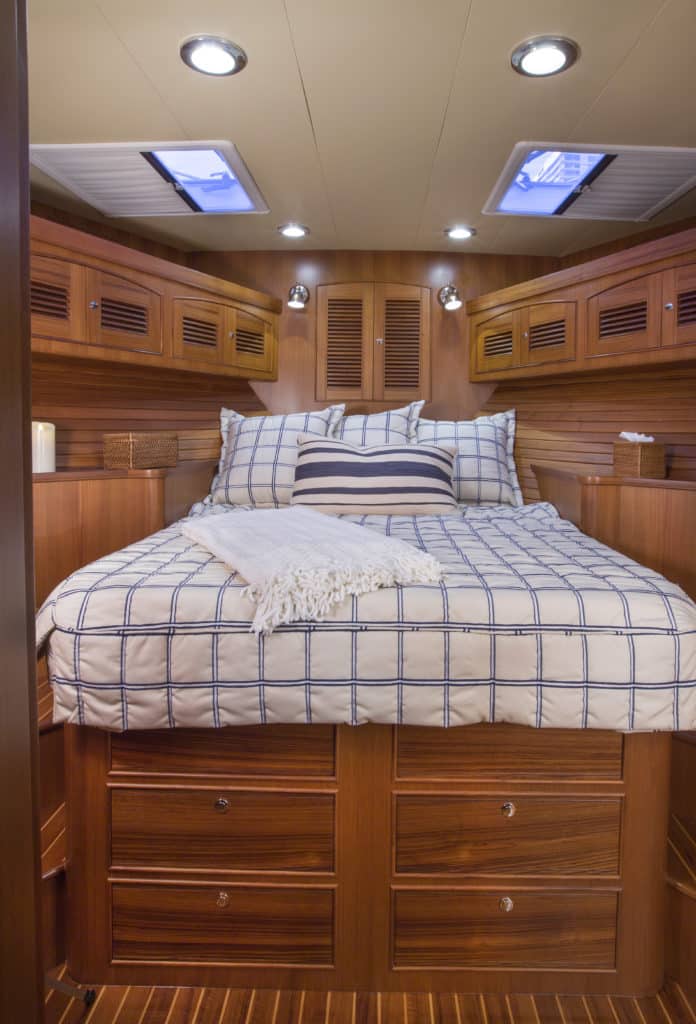
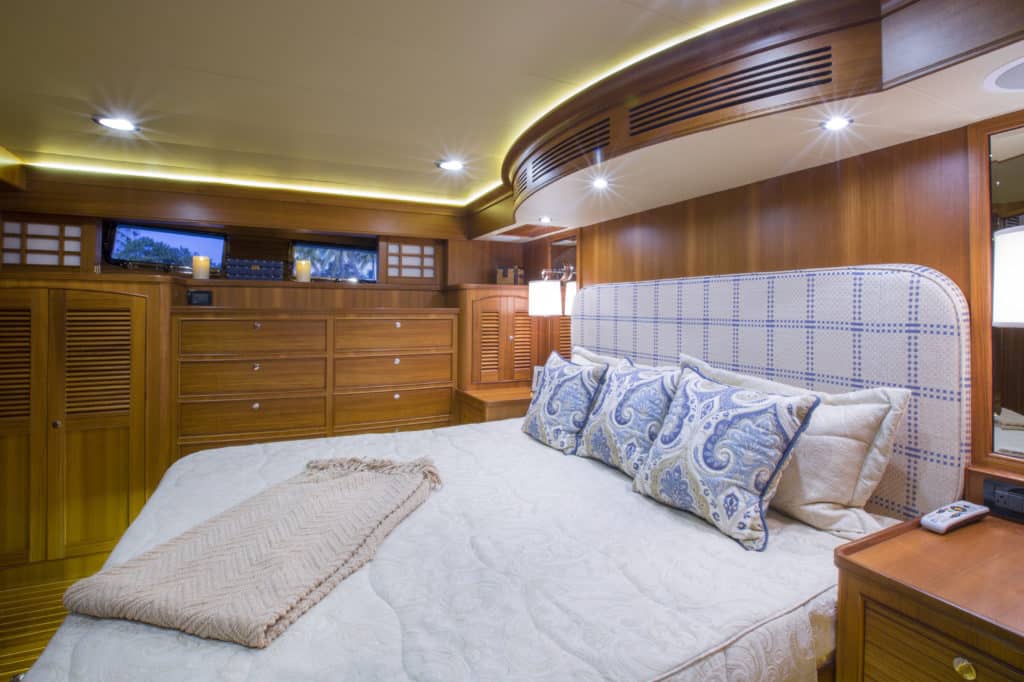
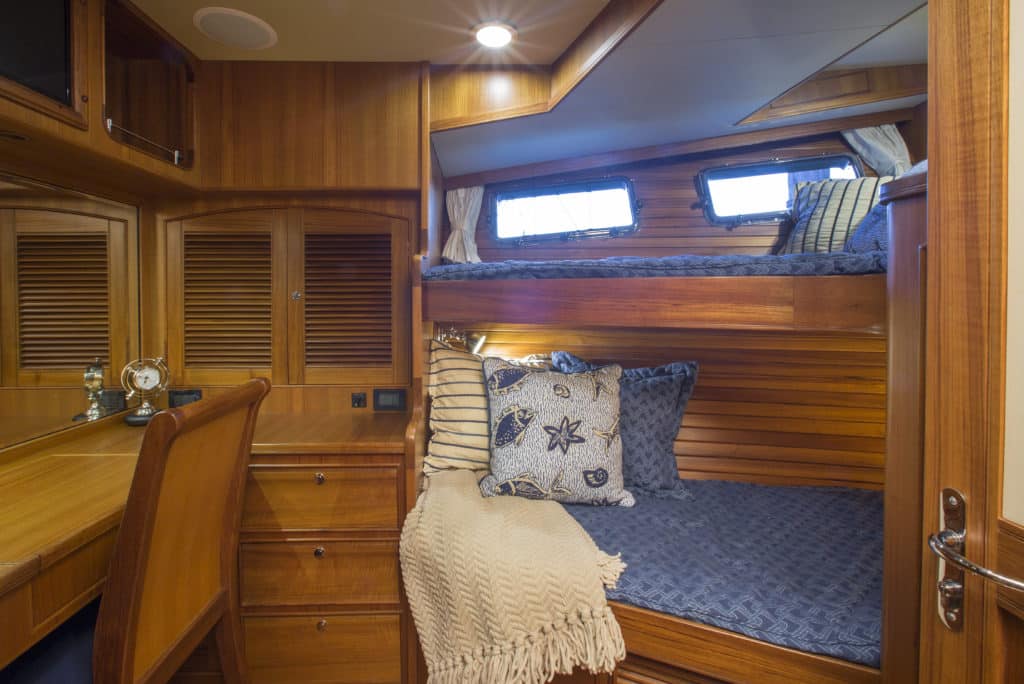
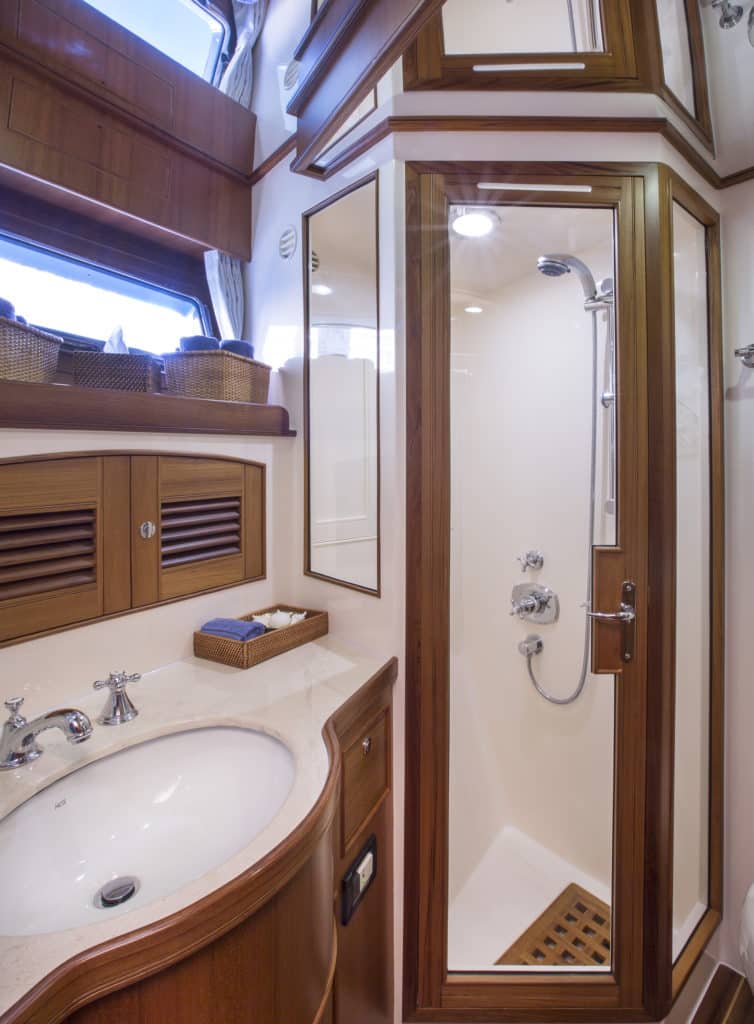
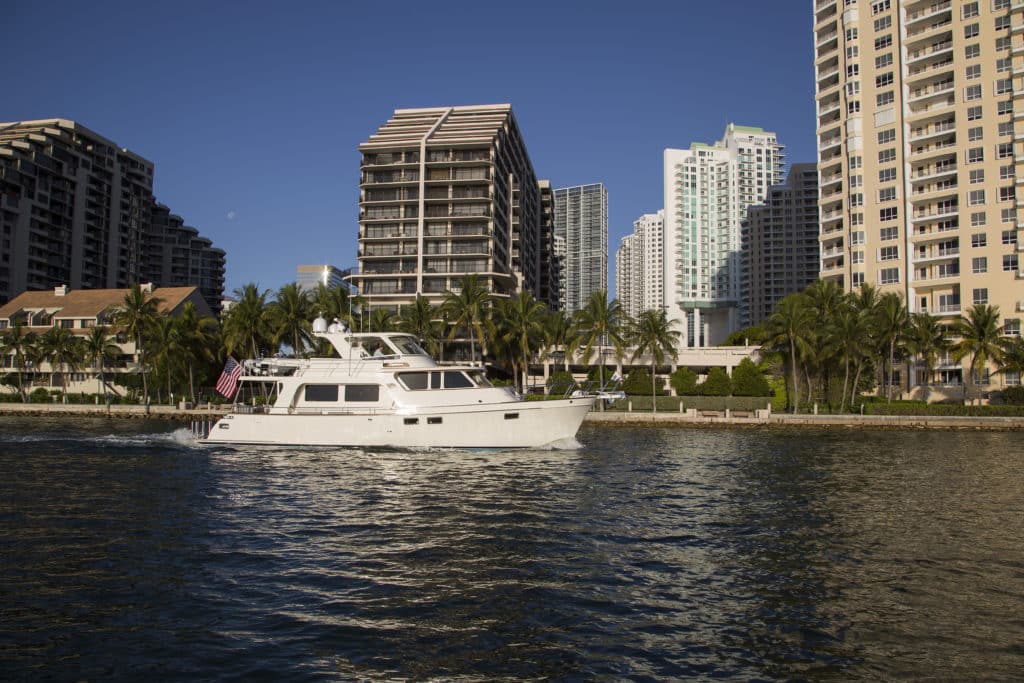
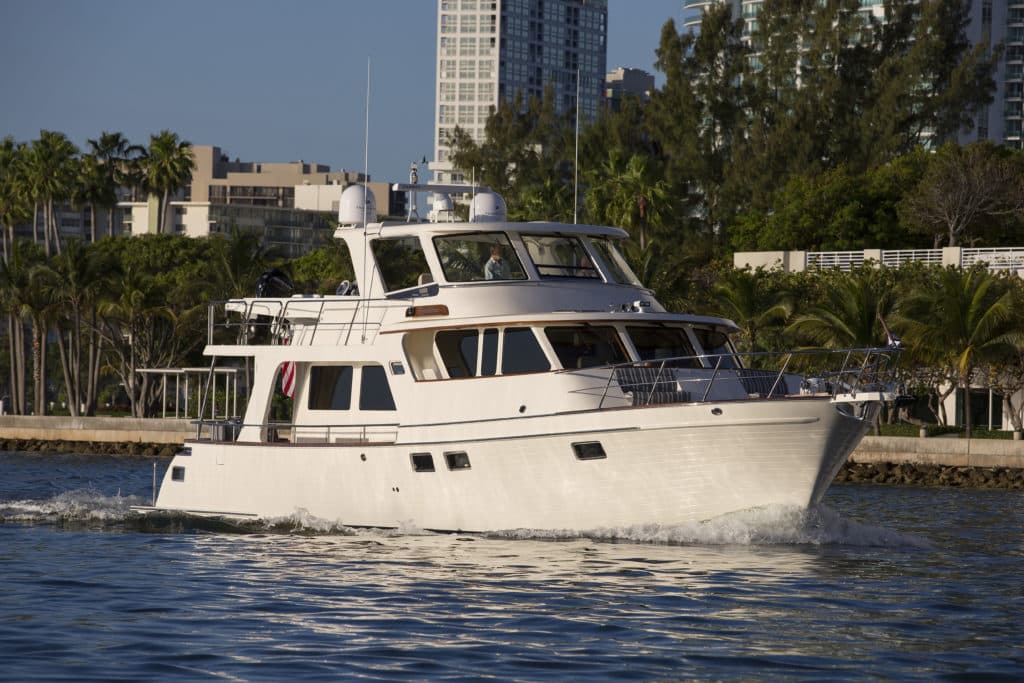
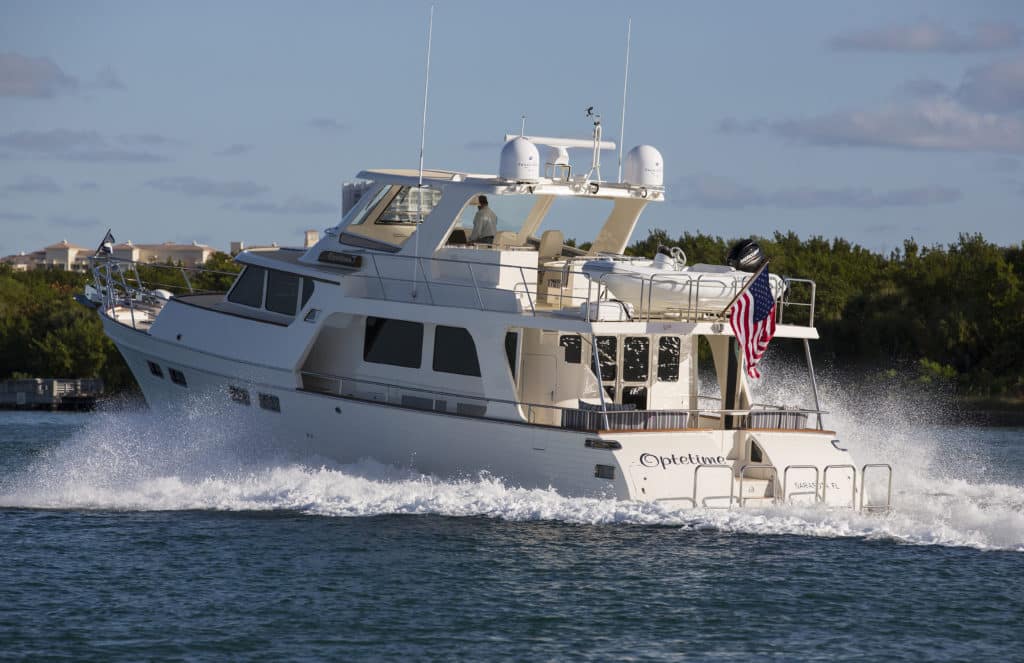
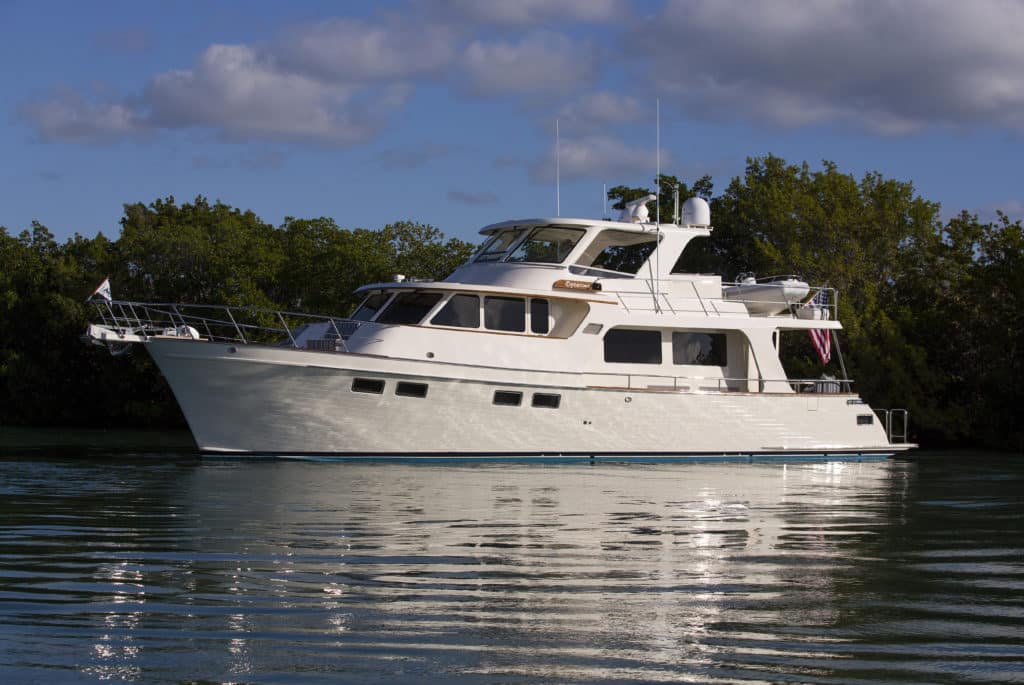
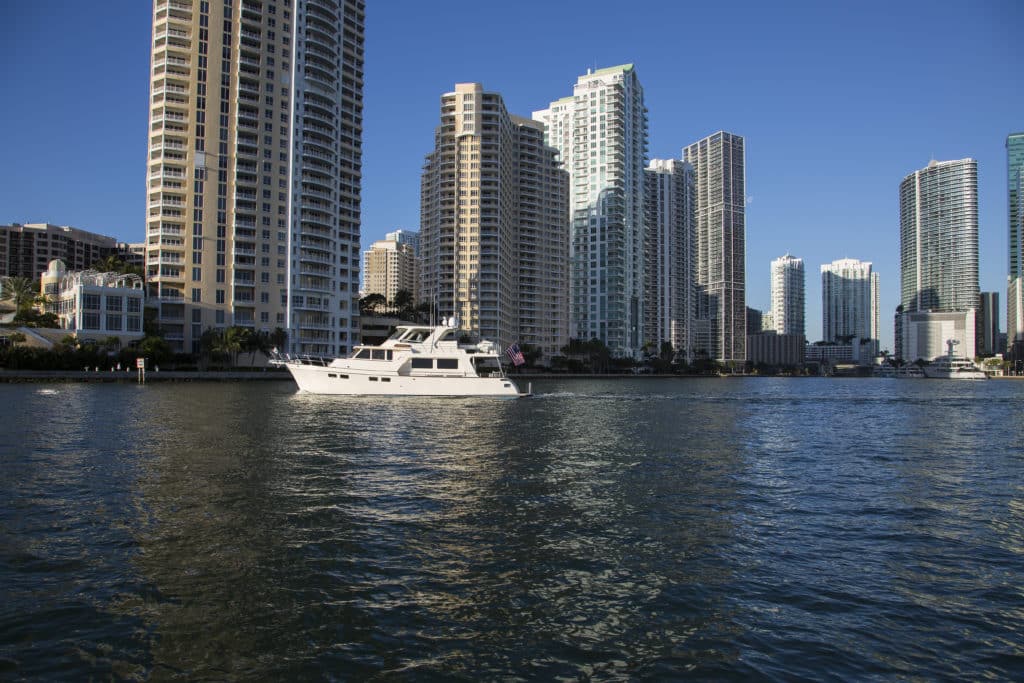
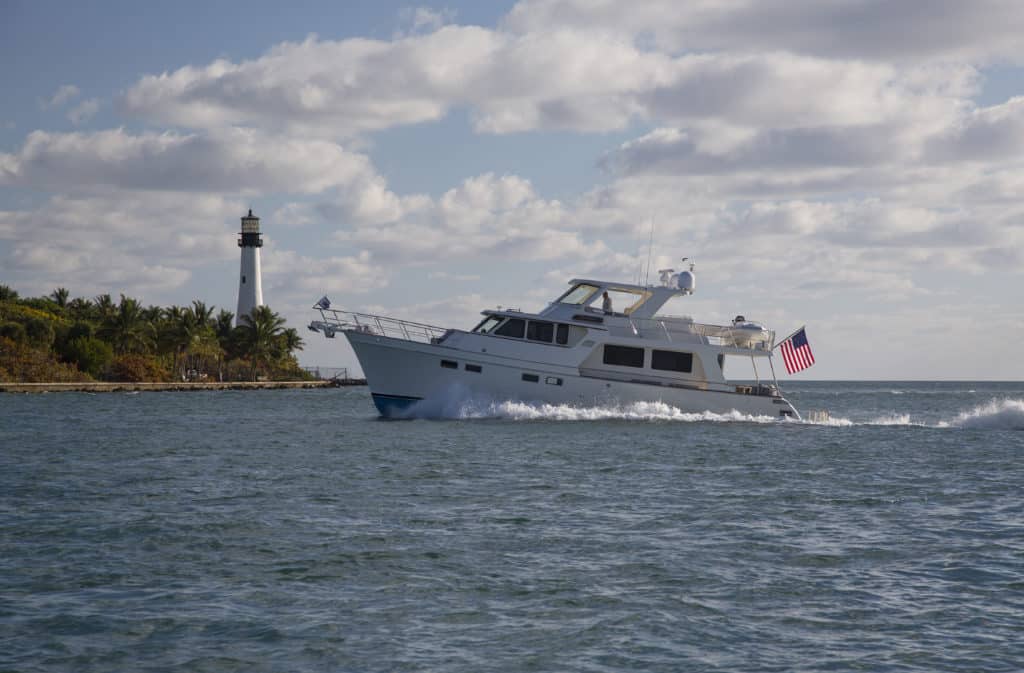
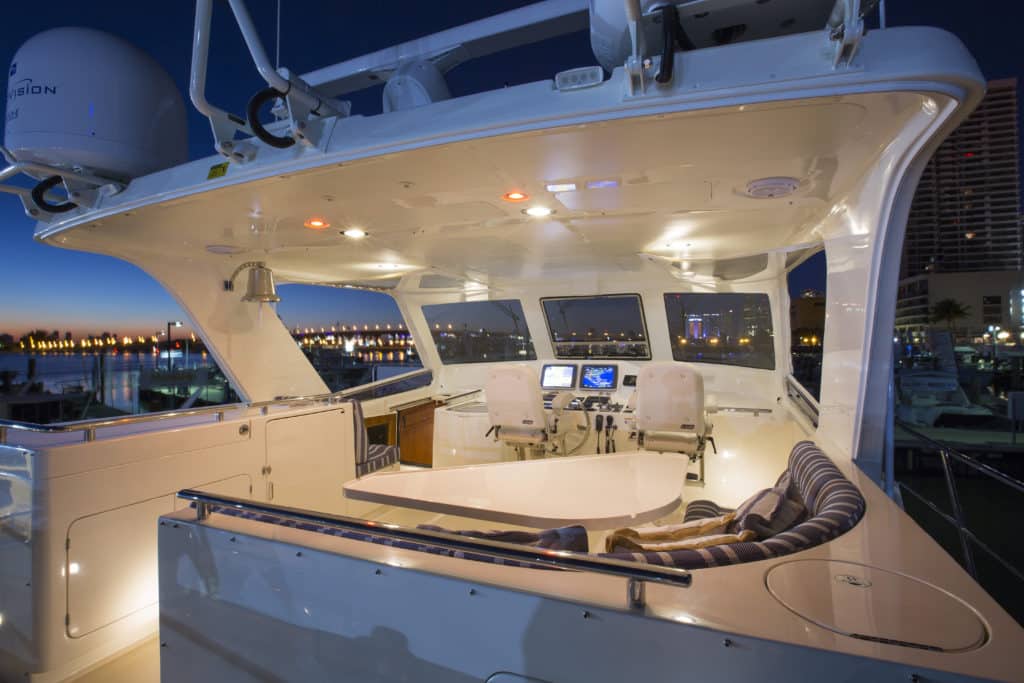
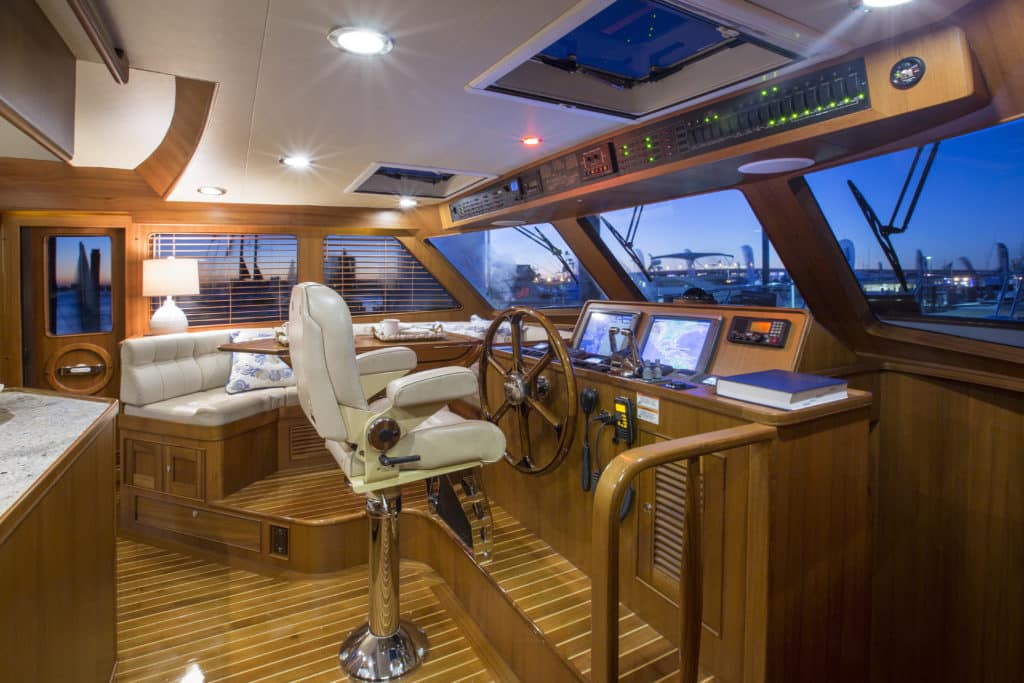
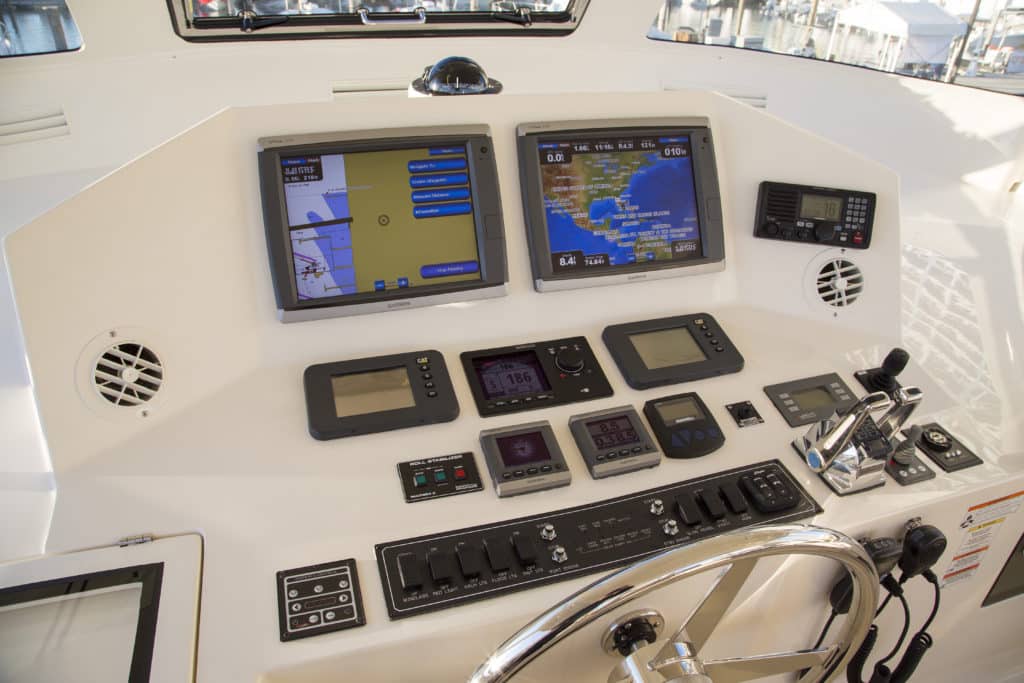
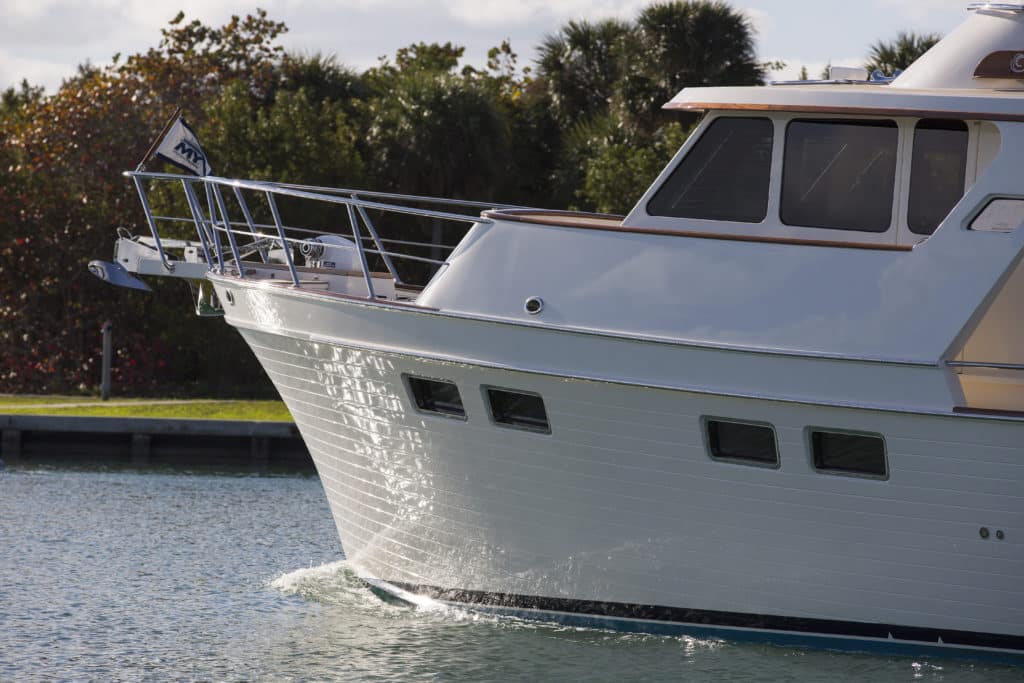
Any number of aphorisms promise dire consequences to anyone who, to use the colloquial, “fixes what ain’t broke,” and it is a brave man, indeed, who flies in the face of such homegrown wisdom. David Marlow is just such a man to take that chance, but he didn’t replace the Marlow 57 rashly. The 57 is not only well loved, but also one of the most popular boats in [Marlow Yachts][] ’ line ranging from 49 to 97 feet, not to mention one that helped cast the builder’s reputation for constructing stylish and seaworthy voyagers.
So creating the 58E (E for Explorer) was handled as one might pick up a prickly sea urchin: carefully and with much planning. And, while Marlow drew on many of the features that made the 57 successful, the 58E is a completely new vessel that started from a blank sheet of paper. No “let’s-use-the-hull-mold-we-have,” although he does say his drafting hand was guided by comments over the years from his yachts’ owners.
In Marlow’s words, “We friendlied her up a bit,” and that says it all. To keep the suspense down, let me say that the 58E is a remarkable yacht that draws on the Marlow DNA (she’s easily recognizable as one of the clan), but she has a personality that is fresh and new. So much for proven aphorisms.
The essence of the 58E is that she has better performance and more internal and external volume than her predecessor. The numbers tell the story. Her centerline length grew 10 inches over the 57, but the waterline length increased 16 inches and the beam widened 4 inches. The 58E’s displacement remains the same as the 57’s, and, if you were to examine the two boats out of the water, you would see more bell-shaped forward sections making for a soft impact with the vee’d portion. The increased volume keeps the bow from plunging. In essence, a clean entry and excellent buoyancy, as well as increased stowage, equipment and living space.
| Specifications | Builder Supplied Number |
|---|---|
| LOA: | 59’1″ |
| LWL: | 54’4″ |
| BEAM: | 18’6″ |
| DRAFT: | 4’10” |
| DISPL.: | 69,000 LB. |
| FUEL: | 1,500 GAL. |
| WATER: | 300 gal. |
| ENGINES (std.): | 2 x 575 mhp Caterpillar C9 diesels |
| ENGINES (tested): | 2 x 1,015 mhp Caterpillar C18 diesels |
| PRICE: | On request |
So how is the additional volume put to use? The full-beam master suite is similar to the one on the 57, but there’s extra space in the portside guest stateroom. There is more space in the engine room, and both the lazarette (increased by 30 percent) and crew quarters are larger. This yacht’s transom sports a stylish radius, and, more important, the afterdeck has grown significantly.
Another change on the 58E is the use of a semienclosed bridge, a feature that Marlow introduced on its 70-footers. It turns the area into an all-weather living space without increasing bridge clearances.
My introduction to the 58E was in the comfortable salon, where I nursed a needed coffee in one of the wing chairs. I hesitate to use the decidedly un-nautical term homey, but the word came to mind. With a couch, chairs, coffee table and TV, this is the living room for the yacht.
Up four steps is the pilothouse, and it’s open to the salon, so neither area feels enclosed. On the way up those steps, pause to consider a most seamanlike electrical panel behind teak-framed Lucite doors. I’ve always hated builders that place electrical panels so low that I have to get on my knees to read the labels. In this case, each label is backlit and at eye level, making this a very user-friendly panel.
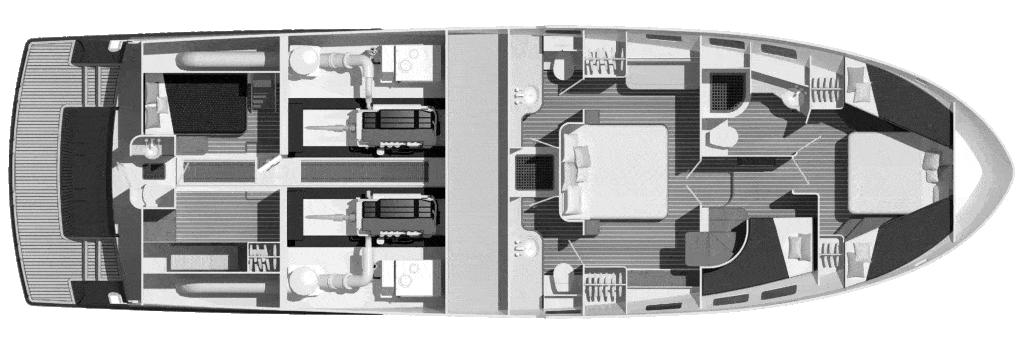
Depending on whether you want a lower helm station (which you may not because the bridge is so well protected), the pilothouse area can be customized. The original drawings for the 58E showed the galley forward and a formal dining table in the no-helm pilothouse, but my test boat had the inside helm forward, a spacious dinette to port and the galley across the after bulkhead. I think this is what I would choose, because it’s a comfortable arrangement for long-distance cruising: The skipper is safely inside in air-conditioned/heated comfort, there is a dinette for meals, and the cook doesn’t feel ostracized. A wide granite countertop with good sea rails to prevent spills separates the helm area from the U-shaped galley, which is lined with enough drawers, lockers and cubbyholes to delight a chef.
The helm is seamanlike with a single pedestal chair, an inlaid teak steering wheel and a raked teak dashboard with visors so the two Garmin 1215 monitors don’t pick up reflections from the windshield. Overhead, an electrical panel includes a complete ship’s monitor and alarm system overlaid on a profile of the 58 with red-light warning indicators.
A pair of swinging flush-mounted pantograph doors are to port and starboard, providing access to the walk-around side decks and a Portuguese bridge. Folding doors in the forward coaming provide blue-water protection as well as access to the teak-planked foredeck, lounge area and anchor platform.
Inside the pilothouse is a stairwell leading to the bridge, and this is a good place to mention a couple of other changes Marlow made with the 58. He developed a new design for the stairs leading from the afterdeck, and the inner pilothouse stairs follow the same thinking: low-rise steps that are easy on the knees, solid handrails and good nonslip surfaces. “It seemed civilized to be able to carry drinks up or down easily,” he says with a grin.
Down a curving (and gentle) stairwell from the pilothouse are the cabins, with the master suite amidships for minimal motion at sea. My test boat had the head to port, and the big shower with a seat invites long, hot soaks. This cabin has a built-in bureau with 10 drawers, plus a pair of hanging lockers, including one big enough to require double doors.
Just forward of here is a guest cabin, which does double-duty as an onboard office with a built-in desk. Upper/lower bunks save space, as do the double-entry doors that open clear of the cabin space when entering or leaving.
Forward, the VIP cabin fills the bow with a raised berth, planked teak ceilings and stowage both around and under the berth. The en suite head features an oversize stall shower with teak-framed door.
| RPM | KNOTS | GPH | dB(A) |
|---|---|---|---|
| 600 | 6.7 | 2.1 | 62 |
| 900 | 8.4 | 3.4 | 62 |
| 1200 | 9.8 | 17.9 | 66 |
| 1500 | 11.2 | 37.0 | 66 |
| 1800 | 19.0 | 57.5 | 66 |
| 2100 | 22.8 | 72.4 | 66 |
| 2260 | 27.9 | 103.2 | 68 |
My favorite place aboard the 58E was the flybridge. Semienclosed means different things to different builders, and this version is a good solution for all-weather use. This isn’t just a tacked-on extension to the hardtop; it’s a completely new mold that increases the size of the top and provides a smooth and fair transition to the three permanent windows forward. The center window opens for fresh air, and all three have large windshield wipers.
The sides of the bridge are easily enclosed with the EZ2CY hard windows that stow flat against the overhead and hinge down so there is none of that frustrating rolling up of side curtains. Even better, these are mounted in dedicated receivers so there are no snaps to corrode or freeze up. And if you want full protection, another beautifully tailored aft enclosure, complete with door, buttons up the bridge. Air-conditioning/heating vents are at the helm, and, as Marlow notes, “They won’t cool the entire bridge, but you can blow cool air on the helmsman.”
Standard power for the 58E is a pair of 575-metric-horsepower Caterpillar C9 diesels, but this one had upgraded twin 1,015-metric-horsepower C18 Cats. With the C18s, I recorded a top speed of 25.6 knots at 2,200 rpm as we flew past a not-to-be-named competitor. A prop swap at the factory provided better performance, reflected in our test data chart. Cruise speed with the C18s should be faster than 20 knots, and at 8-plus knots the 58E uses one gallon per nautical mile for a range greater than 1,400 nm.
The engine room is always a pleasurable space to visit on a Marlow, and the 58E is no exception with easy access from the crew quarters, which, in turn, are reached from the transom in port or via stairs from the afterdeck underway. In this case, the white gelcoated bilge showed off the expected tidiness and accessibility of Marlow installations.
The engine cooling water and fuel piping, for example, is not just floppy hose but instead carefully mandrel-bent stainless-steel pipes, each given an internal anti-corrosive coating for long life.
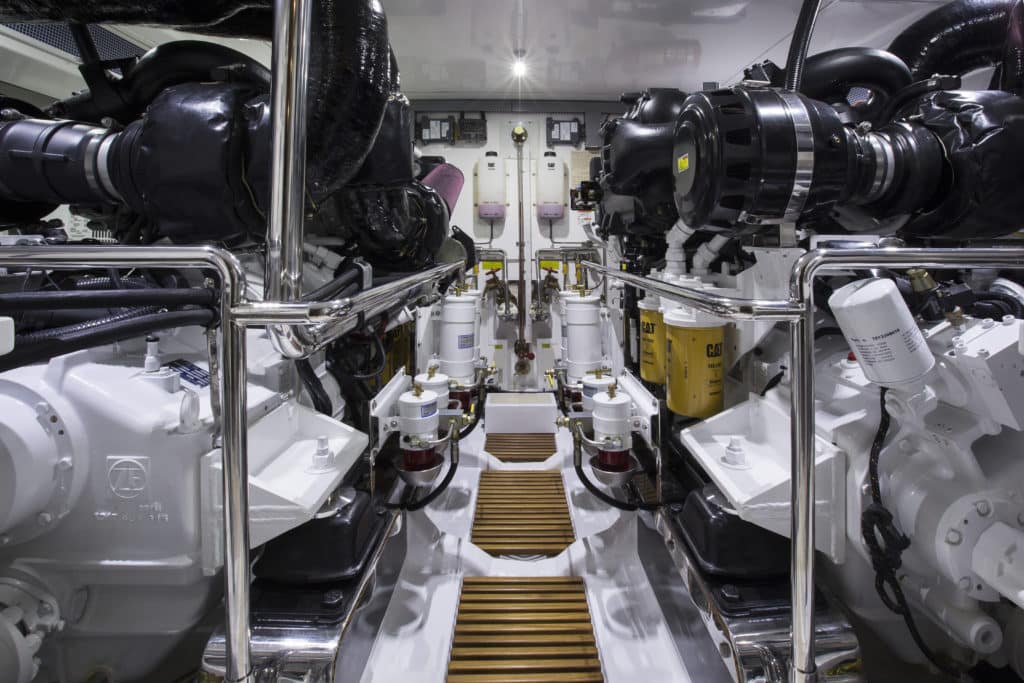
One benefit of the added volume in the 58E is that the fuel capacity was increased to 1,500 gallons. But the real story with the Marlow fuel tank is that it’s cleverly designed without a flat bottom that can attract sediment. Instead, it “notches” downward to a sump at its base for the pickup, allowing the use of nearly all available fuel. The diesel returns are to the top of the tank (along with fills on both port and starboard), so the hot fuel cools before it nears the pickup for maximum efficiency.
One of the things I particularly like about Marlows is that the company believes in systems redundancy. The steering, for example, has three separate levels. First, of course, is the fly-by-wire that links the bridge, pilothouse and any ancillary positions. A second fly-by-wire system is also installed, and, if the first fails, the second comes on line at the flip of a switch. Last, a large pump much like an autopilot hydraulic pump is linked directly to the rudders, with a joystick at both helms for rudimentary left-right controls in an emergency. It won’t be a lot of fun, but it will get you home.
Another system allows the crew to lock off a damaged rudder in the centered position and then switch all steering to the good rudder. Again, not something you plan to use, but if you tag a coral head, the system could save the bacon.
For Marlow, all of his yachts are works in progress because, as he admits, “I just keep foolin’ with them.” The 58E was a bold move to replace a popular yacht, but she is a vessel that sets the bar even higher for other builders.
As Marlow says, “I’m going to be dead a long time and my name’s still going to be on it, so each boat has to be perfect.”
There’s an aphorism with real wisdom.
Innovative Marlow Tank Design
The 58E features this builder’s proprietary Marlow Captive Sump fuel tank, which is shaped like the vessel’s deadrise and located on the longitudinal center of balance (LCB) so it doesn’t affect trim or cause pitching like a tank located forward of or abaft the LCB. If a 1,500-gallon tank is located 8 feet abaft LCB, it would generate more than 87,000 pounds of pitching moment. Not only does this tank have a centerline sump that holds about 90 gallons, but also the slope of its sides, combined with Z-shaped baffles, causes significant “flushing” of sediment. With a minimum corner radius of 2 inches, there are no recesses to trap fuel crud or algae that can break loose on a rough day to clog the fuel filters. A fuel pickup for the main engines is at the bottom of the sump, while the generator pickups are staggered so they will run out of fuel sequentially before the mains. The fuel returns from the engines are at the top of the tank, so fuel is cooled before it reaches the pickup point. The fiberglass tanks, which have ABS, BV, ABYC and Germanischer Lloyd approvals, are fireproof and coated with a smooth finish designed for fuel systems. Aside from the innovative design, a desirable feature of the Marlow tank is a man-size port in the top, allowing a worker to enter the emptied tank and polish the interior to keep it spotless.









